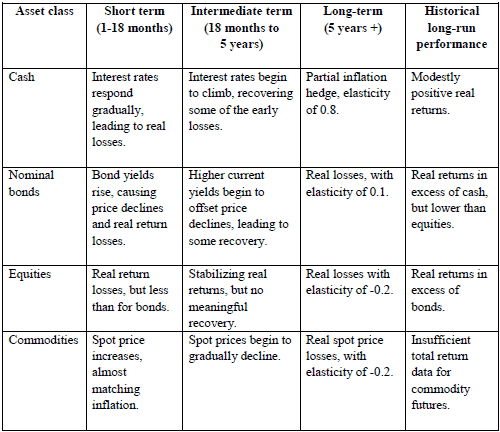How can long-term investors best hedge against inflation’s erosion of purchasing power? In their April 2009 paper entitled “Inflation Hedging for Long-Term Investors”, Alexander Attie and Shaun Roache assess the inflation hedging properties of traditional asset classes over different investment horizons. Using total return indexes for several asset classes from initial data availability (January 1927 at the earliest) through November 2008, they conclude that:
- Over a one-yearinvestment horizon:
- Cash has not been an effective hedge against inflation.
- Stock and bond returns tend to decrease as the inflation rate rises, particularly since 1973. A 1% increase in the inflation rate over a one-year period leads to a decline in the nominal annual return on bonds (equities) of about 1-2% (3%).
- Commodity returns tend to increase as the inflation rate rises. A 1% increase in the inflation rate over a one-year period leads to an increase in the nominal annual returns for the CRB Index, the GSCI and the spot gold price ranging from about 4% to 10%.
- Over the longrun:
- Cash returns gradually increase with the inflation rate, but the response is less than offsetting.
- Long-term Treasury bonds are the worst inflation hedge immediately after an inflation rate shock, but after about 3 years return dynamics begin to work in their favor and higher yields offset price declines.
- Equity returns decline in the months following an inflation shock and do not meaningfully recover, making them the worst inflation hedge over the long run.
- Commodities are the best performing asset class over the short term, but long-term implications of inflation on the business cycle cause their prices to fall gradually over the long run.
- The dynamics of deflation shocks may be very different.
- Investors may be able to enhance inflation protection through tactical asset allocation by tilting toward commodities and away from bonds immediately after positive inflation shocks, but then reversing that tilt when commodity returns begin to diminish. Equity reallocations are less efficient in hedging against higher inflation, and investors should perhaps view equities as very long-term holdings for which inflation cycles average out.
The following table, taken from the paper, summarizes the effects of unexpected increases in the inflation rate on returns for different asset classes based on available index data. Elasticity is the cumulative percent change in the asset class total return divided by the cumulative percent change in inflation. An elasticity of 1 indicates that the asset class provides a perfect hedge against inflation shocks.

In summary, evidence indicates that inflation hedges effective over the short run, such as commodities, may not work over long horizons and that tactical asset allocation following inflation surprises could enhance long-term investment returns.